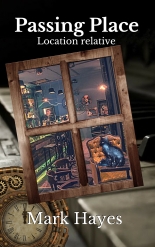It was a scene from a vision of Fuseli, and over all the rest reigned that riot of luminous amorphousness, that alien and undimensioned rainbow of cryptic poison from the well—seething, feeling, lapping, reaching, scintillating, straining, and malignly bubbling in its cosmic and unrecognisable chromaticism.
Now there is a sentence with a life of its own. No one could accuse Lovecraft of underselling the strangeness of the life form that falls to earth in a quiet rural backwater of New England. This is life, if that’s the correct word, but not as we know it, not as we know it at all. Which is the key in essence to this whole tale, life is almost undoubtedly out there in the cosmos, the universe is too big for that to be otherwise. But life as we know it, nice, simple, understandable, carbon-based life, well of that there is probably little doubt too, but it is no more unlikely than life as we don’t know it. Life that did not evolve from the same roots of the tree as us. Indeed, not to put too fine a point on it, we can’t even be entirely certain there isn’t life on our own little mud-ball which isn’t actually life as we know it. Frankly, if your search for life is based on the premise of that it must be carbon-based, you have already narrowed the scope of your definition, and perhaps that in itself is the first mistake. But if we can’t even trust our definition of Life on our own planet, then how can we rule out the possibility of life out there in the endless beyond not perhaps conforming to that definition.

And if it doesn’t? If something falls to earth that isn’t just alien in the rubber costume, extending neck, light up finger with a strong desire to ‘phone home’ kind of alien. Not a carbon-based, understandable alien that while beyond our experience is not beyond our comprehension… What if it is something utterly alien to us on a cellular level, on a DNA level, on the level of amino acids and the basic building blocks of everything we understand as alive in our narrow carbon-based way? What then…
You can call Lovecraft a lot of things, and over the course of the last couple of years or so god knows I have, but by the last 20’s (1927 in this case) he was writing not only some of his best fiction but also some of his most insightful, and ‘The Colour Out Of Space‘ is certainly both. Even more so when you consider that science at the time had yet to get to grips with cellular life and DNA. To say no one was writing stories quite like this back in the 1920’s is an understatement because while it was written almost a century ago it still has much about it that seems strange and beyond the scope of the universe in our very human definitions. It was also, far more than even ‘The Call of Cthulhu’ a breakout story for old tentacle hugger, it was one of his first stories to receive broad praise and re-publication beyond the confines of ‘Amazing Stories’ and other pulp magazines.
It’s also definitely ‘Colour’ not ‘Color’, which as Lovecraft wrote exclusively in American English suggests a definite choice on his part. Perhaps the choice of spelling was a subtle way to inject a little of the alien into the title, just to throw his mostly American audience off kilter a tad.
Ostensibly the story of a Boston surveyor visiting a remote rural area known locally as ‘Blasted Heath’, and investigating the rumours around how the area came to be abandoned and spurned by the locals. It is what he discovers as he investigates that is so compelling about this tale. Lovecraft, who was a bit of a strange bod at times as you know, excels at describing the weird and uncanny. The description of the heath and its strange flora and fawner, of plants that glow a little in the dark and fruits that ripen sour and inedible, and of all the strange events following a meteor crashing to earth forty years before the story is set, is a masterpiece of strangeness. Something alien is about in this remote part of New England, something so alien it is almost beyond comprehension. And it’s still there, dormant, perhaps waiting, though if it’s waiting for something, who cares even to guess what that might be, and what may happen when its waiting is done…
Of all Lovecraft’s tales, this is perhaps one of the strangest, and yet the most readable. there is a reason it remains so well loved today. It also still seems a modern tale, where other stories may have dated, or become fractured by time, this could, with little changed, be written and set today, and it would still seem as vital, oddly possible and not entirely unfrightening possibilities it provokes. Life, as we know it out there in the cosmos, may come down here one day, if we are lucky it will only be that, life as we know it…
It gets all the tentacles and my unhesitating recommendation, if you’re looking for a story that will make you lay awake with thoughtful if rather chilling possibilities floating around your mind…














